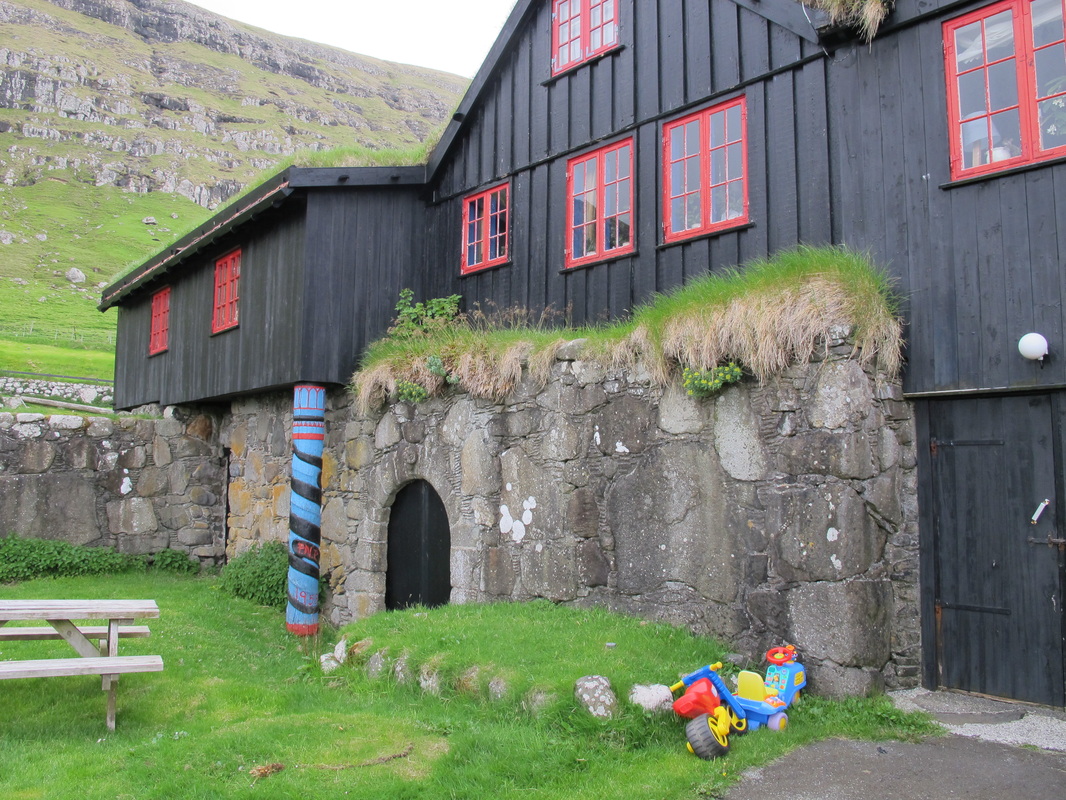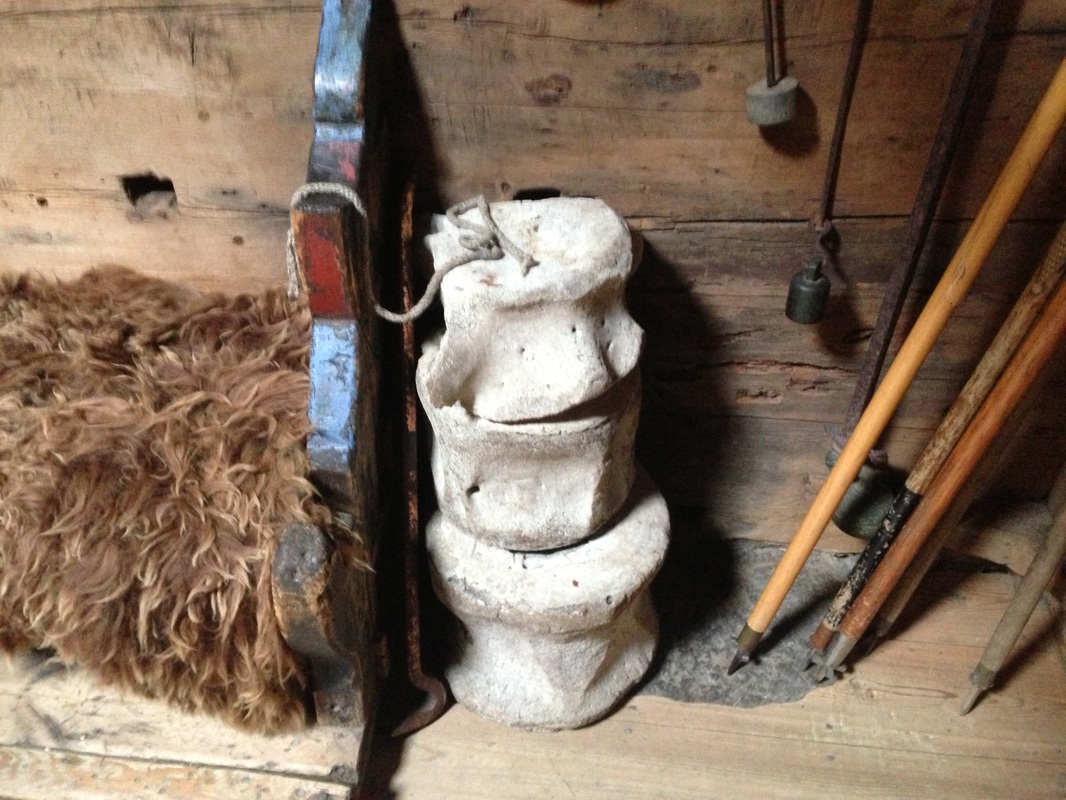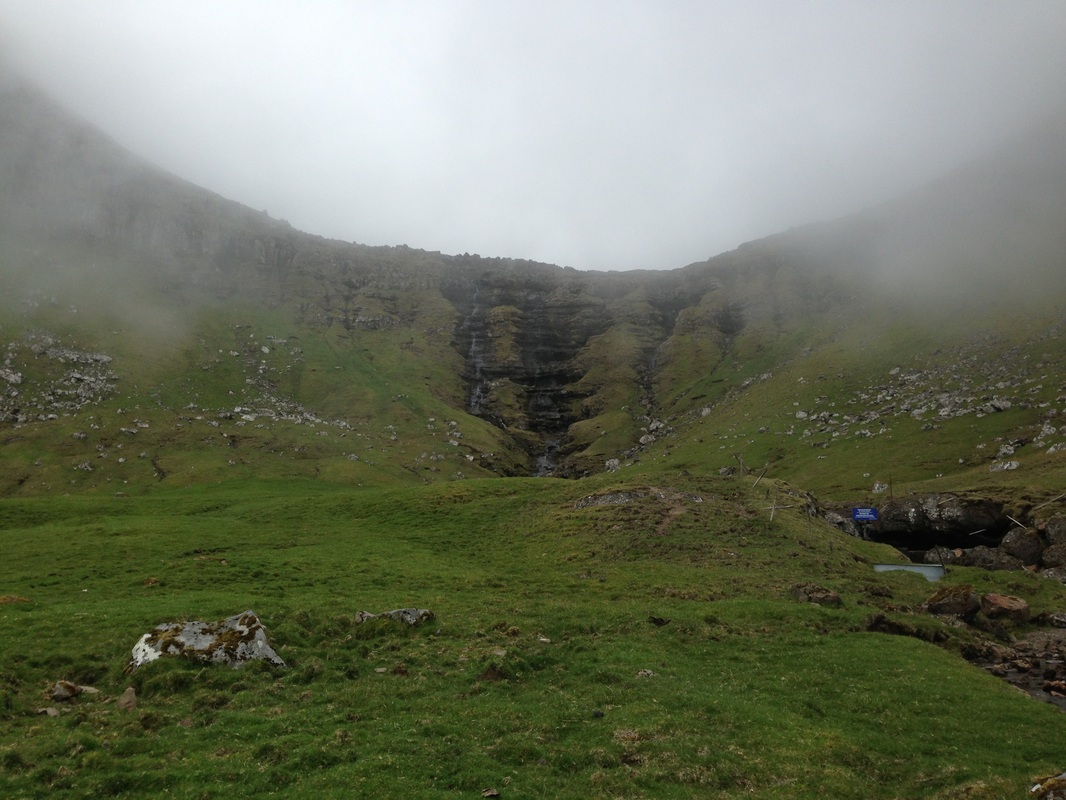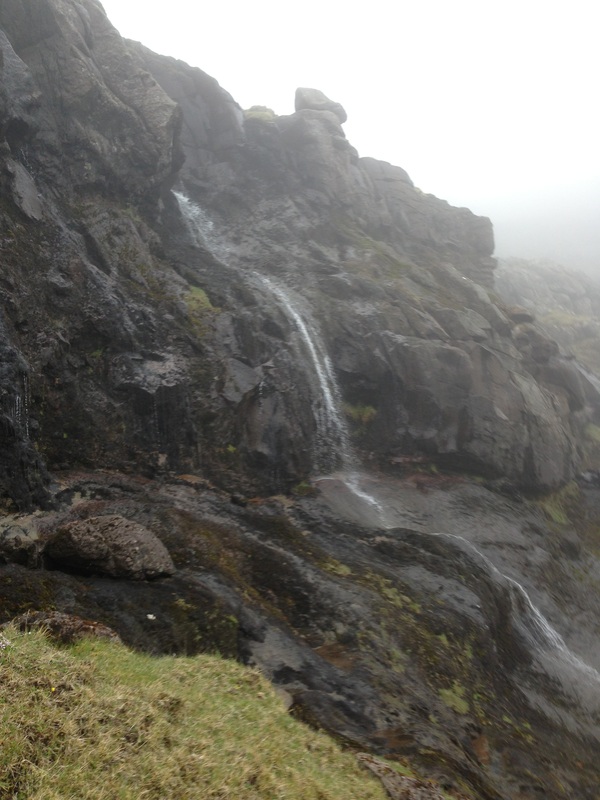I hired a bike on my press trip to the Faroes - or rather the tourist authorities did. You see I thought I'd do a bit of self-guiding round the islands, which would make it easier for them as they wouldn't have to plan anything. And I'd have free time.
The bike shop was owned by a man called Daniel. Or maybe the shop was called Danyul.
"This is perhaps unique," I remember saying casting my eyes around the place.
"Why?" said the owner of the shop who may or may not have been called Daniel.
"Because I've never seen seen a shop that sells fully fitted kitchens and bicycles and nothing else. I especially like how you've stacked the bikes between the kitchen units."
"I was worried I wasn't making enough money from the bikes so I went for the kitchens as well. It seems to work."
"With the limited marketplace presented by a small population I suppose it pays to be flexible," I said.
In the Faroes the roads are empty of traffic but filled by the wind.
On the four mile hill out of Torshavn I was determined and beat a force 8 gale into submission. I was rewarded with a two and a half mile down hill to the most historic spot on the islands which turned out to be a medieval ruin with an ugly cap to save it from further ruin. I think I would prefer it ruined. The name of village was Kirkjubour.
The ruin was a church, apparently the first stone building the islanders had ever built dating from the late 1200s. This seemed a tad late and maybe even lazy.
Since there are very few trees on the islands and the whole place is filled with rock - albeit tough basalt - then building houses from driftwood and deliveries of timber from Norway seemed somehow avoiding the obvious building material - stone - all around.
Better by far than the scruffy ruin of the oldest stone building was the trad house next door which the owners had left open for visitors to investigate.
This was a delightful essay in the plastic nature of wood. It was a lovely place, a liveable place, warm. There were odd touches too, three stools were composed of whale vertebrae.
The bike shop was owned by a man called Daniel. Or maybe the shop was called Danyul.
"This is perhaps unique," I remember saying casting my eyes around the place.
"Why?" said the owner of the shop who may or may not have been called Daniel.
"Because I've never seen seen a shop that sells fully fitted kitchens and bicycles and nothing else. I especially like how you've stacked the bikes between the kitchen units."
"I was worried I wasn't making enough money from the bikes so I went for the kitchens as well. It seems to work."
"With the limited marketplace presented by a small population I suppose it pays to be flexible," I said.
In the Faroes the roads are empty of traffic but filled by the wind.
On the four mile hill out of Torshavn I was determined and beat a force 8 gale into submission. I was rewarded with a two and a half mile down hill to the most historic spot on the islands which turned out to be a medieval ruin with an ugly cap to save it from further ruin. I think I would prefer it ruined. The name of village was Kirkjubour.
The ruin was a church, apparently the first stone building the islanders had ever built dating from the late 1200s. This seemed a tad late and maybe even lazy.
Since there are very few trees on the islands and the whole place is filled with rock - albeit tough basalt - then building houses from driftwood and deliveries of timber from Norway seemed somehow avoiding the obvious building material - stone - all around.
Better by far than the scruffy ruin of the oldest stone building was the trad house next door which the owners had left open for visitors to investigate.
This was a delightful essay in the plastic nature of wood. It was a lovely place, a liveable place, warm. There were odd touches too, three stools were composed of whale vertebrae.
Outside I sat on a wall and ate a sandwich as the ocean slapped on the rocks. To the south west islands dipped in and out of cloud. On one island a village of twenty houses only reachable by boat looked like the last place on earth. How strange to live in such isolation.
The healthy stink of seaweed dankly perfumed the air.
It was beautiful.
I followed the west coast of Streymoy north past a village called Unpronounceable to the village called Howthehelldotheysaythat with three houses which made hamlets look tiny.
In the first village was a school with a playground with the best sea view in the world. There was an abandoned football there that was either all the joy of youth yet to be bittered by experience or a small plastic sphere somebody had carelessly forgotten. The Faroese landscape makes you think epic thoughts, you can't help yourself.
There seems to be a department in the Faroese government which artfully leaves kids toys about in villages, footballs, kids sit-on tractors and so on. You never see kids, you never see anybody in these villages, but you see toys and signs of life as though people have just left or are just about to arrive. It's unsettling.
I cycled on. After a preposterous gorge, as though somebody had hit the coast with an axe, I continued up a very steep hill and disappeared into mist. This didn't bother me. The good thing about mist in June on the Faroes is that you don't have to worry about it getting dark.
I'd seen on the map that four miles up the coast road there was a path which took me east back, over a single mountain to Torshavn. It was a wonderful short cut and armed with a mountain bike, I was looking forward to it.
Unfortunately the map was a liar, the cartographer a clown.
The map said a path followed a stream up to the ridge. I couldn't see the ridge because although I had come down out of the mist it was still covering the higher ground.
Sod it, let's go I thought. Push the bike up and then ride down the other side.
A third of mile up the non-path marked by the map-making liar I hit a snag. The grass path that was merely the same grass as elsewhere with oyster catchers, curlews, flocks of geese and ravens for company, hit the mist line. I stared at the fibbing map again and the path that wasn't there. It said the path followed the stream and I was following the stream so I must be on the right non-track I decided.
Another ten minutes of toiling the mist cleared for 120 seconds. I couldn't believe what I saw. There was still no path but there was a seventy foot cliff with a waterfall. I looked back at how far I'd dragged the bike. I really didn't want to return that way and have to cycle all those miles and hills back to Torshavn.
The healthy stink of seaweed dankly perfumed the air.
It was beautiful.
I followed the west coast of Streymoy north past a village called Unpronounceable to the village called Howthehelldotheysaythat with three houses which made hamlets look tiny.
In the first village was a school with a playground with the best sea view in the world. There was an abandoned football there that was either all the joy of youth yet to be bittered by experience or a small plastic sphere somebody had carelessly forgotten. The Faroese landscape makes you think epic thoughts, you can't help yourself.
There seems to be a department in the Faroese government which artfully leaves kids toys about in villages, footballs, kids sit-on tractors and so on. You never see kids, you never see anybody in these villages, but you see toys and signs of life as though people have just left or are just about to arrive. It's unsettling.
I cycled on. After a preposterous gorge, as though somebody had hit the coast with an axe, I continued up a very steep hill and disappeared into mist. This didn't bother me. The good thing about mist in June on the Faroes is that you don't have to worry about it getting dark.
I'd seen on the map that four miles up the coast road there was a path which took me east back, over a single mountain to Torshavn. It was a wonderful short cut and armed with a mountain bike, I was looking forward to it.
Unfortunately the map was a liar, the cartographer a clown.
The map said a path followed a stream up to the ridge. I couldn't see the ridge because although I had come down out of the mist it was still covering the higher ground.
Sod it, let's go I thought. Push the bike up and then ride down the other side.
A third of mile up the non-path marked by the map-making liar I hit a snag. The grass path that was merely the same grass as elsewhere with oyster catchers, curlews, flocks of geese and ravens for company, hit the mist line. I stared at the fibbing map again and the path that wasn't there. It said the path followed the stream and I was following the stream so I must be on the right non-track I decided.
Another ten minutes of toiling the mist cleared for 120 seconds. I couldn't believe what I saw. There was still no path but there was a seventy foot cliff with a waterfall. I looked back at how far I'd dragged the bike. I really didn't want to return that way and have to cycle all those miles and hills back to Torshavn.
I looked at the cliff again before the view disappeared.
There were a couple of possible routes.
It took me half an hour but I managed it although the bike and I reversed our relationship. It rode me. Or rather I carried it, which is the same thing.
It was a heavy bike but by edging on ledges I got there, frequently going ahead to find a way and leaving the bike behind like an injured companion - one you weren't friends with any more because they are no help at all. Fortunately the mist was so thick I didn't know how far there was to fall. Ignorance can be an advantage.
On the other side, buoyed by my derring-do, I started riding down the mountain.
Idiot.
The front wheel got stuck in a hollow and I flew over the handle bars but because the ground was so steep I landed on my feet. I landed at a speed just shy of Usain Bolt's PB and careened down the hill in the style of a comedy villain in a Buster Keaton movie.
When I stopped, by throwing myself to my left onto some turf, I looked back. That arrogant machine had wedged itself in the hollow as though it were in a bike rack. I was on my arse and it was still standing. I hated it.
I'd also been whacked on the knee by my camera swinging round. Jeez that hurt. I scrambled for the map. It was a least another mile and half of rough terrain until I hit a road.
I had to go back for the bike. Then I hobbled, my knee in agony, out of the mist line carrying the bloody thing. I yelped and limped to a road and then freewheeled down into Torshavn.
The hotel receptionist looked up as I entered the hotel with my lazy and murderous machine and placed it in the safe room.
"What happened?" he said looking at my mud spattered clothes, worrying about his carpets.
"I fell off the bike on the mountain," I said.
"Were you wearing a helmet?" he asked.
"Not on my bloody knee," I said hopping to the lift.
"That bike hates humans," I shouted over my shoulder.
There were a couple of possible routes.
It took me half an hour but I managed it although the bike and I reversed our relationship. It rode me. Or rather I carried it, which is the same thing.
It was a heavy bike but by edging on ledges I got there, frequently going ahead to find a way and leaving the bike behind like an injured companion - one you weren't friends with any more because they are no help at all. Fortunately the mist was so thick I didn't know how far there was to fall. Ignorance can be an advantage.
On the other side, buoyed by my derring-do, I started riding down the mountain.
Idiot.
The front wheel got stuck in a hollow and I flew over the handle bars but because the ground was so steep I landed on my feet. I landed at a speed just shy of Usain Bolt's PB and careened down the hill in the style of a comedy villain in a Buster Keaton movie.
When I stopped, by throwing myself to my left onto some turf, I looked back. That arrogant machine had wedged itself in the hollow as though it were in a bike rack. I was on my arse and it was still standing. I hated it.
I'd also been whacked on the knee by my camera swinging round. Jeez that hurt. I scrambled for the map. It was a least another mile and half of rough terrain until I hit a road.
I had to go back for the bike. Then I hobbled, my knee in agony, out of the mist line carrying the bloody thing. I yelped and limped to a road and then freewheeled down into Torshavn.
The hotel receptionist looked up as I entered the hotel with my lazy and murderous machine and placed it in the safe room.
"What happened?" he said looking at my mud spattered clothes, worrying about his carpets.
"I fell off the bike on the mountain," I said.
"Were you wearing a helmet?" he asked.
"Not on my bloody knee," I said hopping to the lift.
"That bike hates humans," I shouted over my shoulder.









 RSS Feed
RSS Feed